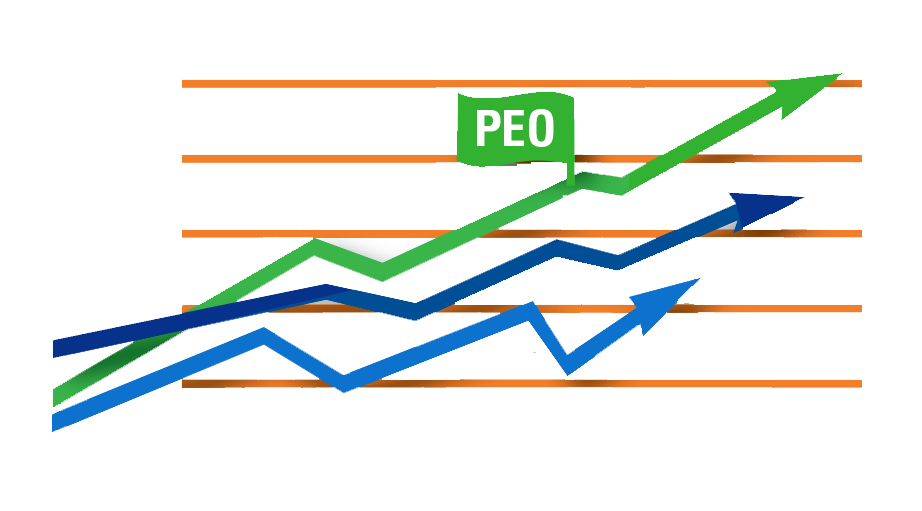What is a PEO?
Professional Employer Organizations (PEOs) provide human resources services to their small business clients—paying wages and taxes and providing compliance assistance with myriad state and federal laws and regulations. In addition, PEOs often provide workers with access to 401(k) plans, health, dental, life insurance, dependent care, and other benefits not typically provided by small businesses. Between 2 and 3 million people are covered by PEO arrangements.
Using a Professional Employer Organization Can Improve Your Business
Reduce payroll and accounting costs
Offer advanced HR services
Manage workers' compensation risks
Keep and attract employees with employee benefits


What is a Professional Employer Organization (PEO)?
Businesses today seek help with increasingly complex, employee-related matters such as health benefits, workers compensation, payroll, tax and human resource compliance, and management of unemployment claims. They contract with a Professional Employer Organization (PEO) to assume these responsibilities and provide expertise in human resource management. This allows the PEO client to concentrate on the operational and revenue-producing side of its operations, and get back to the basics of their business.
Businesses across America have discovered the incredible value of PEOs because they provide:
Relief from the burden of employment administration
A wide range of personnel management solutions through a team of professionals
Improved employment practices, compliance and risk management to reduce liabilities
Access to a comprehensive employee benefits package, allowing clients to be competitive in the labor market
Assistance to improve productivity and profitability
PEOs develop lasting relationships with their clients. Due to strong client satisfaction, PEOs enjoy a nearly 86 percent client retention rate.
PEO Industry Statistics

What Others Are Saying About the PEO Industry
Human Resources Expertise
“You can expect a PEO to act as a sort of satellite office of your company, performing and managing HR functions for the employees it hires on your behalf, including staffing, employee relations, payroll and benefits. Along with taking those duties off your shoulders, PEOs have the added benefit of making your company part of a larger group that includes all the companies it serves. This strength-in-numbers approach benefits you when the PEO negotiates services like benefit plans and health insurance. In that pool, bigger fish get better rates.”
“In a PEO, or professional employer organization, arrangement, a business places all or most of its workforce onto the payroll of an outsourcing firm, which assumes responsibility for payroll, benefits and other human resource functions. The outsourcer virtually becomes the human resources department for its client. Legally, it serves as the co-employer.”
“Thousands of businesses have turned to professional employer organizations (PEOs) for relief. A typical PEO takes over the time-consuming task of HR management, freeing companies to refocus resources on their core discipline. Besides handling a company’s payroll processing, full-service PEOs often provide small and medium-sized businesses with access to big-company benefits they could not offer on their own.”

Frequently Asked Questions
What is a PEO?
Professional employer organizations (PEOs) enable clients to cost-effectively outsource the management of human resources, employee benefits, payroll and workers’ compensation, So that they may focus their efforts on the core of their business.
Who uses a PEO?
Any business can find value in a PEO relationship, but the average client of a PEO is a business with 17 worksite employees. Increasingly, larger businesses also are finding value in a PEO arrangement, because PEOs offer robust Web-based HR technologies and expertise in HR management. PEOs can partner with companies that have 500 or more employees and work in conjunction with their existing human resources department. PEO clients include many different types of businesses ranging from accounting firms to high-tech companies and small manufacturers. Many different types of professionals, including doctors, retailers, mechanics, engineers and plumbers, also benefit from PEO services.
How does a PEO arrangement work?
Once a client company contracts with a PEO, the PEO will then co-employ the client’s worksite employees. In the arrangement between a PEO, a worksite employee and a client company, there exists a co-employment relationship. The PEO assumes much of the responsibility and liability for the business of employment, such as risk management, human resource management, and payroll and employee tax compliance. The client company retains responsibility for and manages product development and production, business operations, marketing, sales, and service.
Are PEOS recognized as employers at the state and federal levels?
Yes. PEOs operate in all 50 states. Many states provide some form of specific licensing, registration, or regulation for PEOs. These states statutorily recognize PEOs as the employer or co-employer of worksite employees for many purposes, including workers’ compensation and state unemployment insurance taxes. The IRS has accepted the right of a PEO to withhold and remit federal income and unemployment taxes for worksite employees. The IRS has promulgated specific guidance confirming the authority of PEOs to provide retirement benefits to workers.
Why would a business use a PEO?
Business owners want to focus their time and energy on the “business of their business” and not on the “business of employment.” Most business owners do not have the human resource training that is necessary to manage a growing company in today’s environment. PEOs help by taking charge of a company’s payroll and accounting, general regulatory compliance, risk management, insurance and employee benefit programs. PEOs give small-group markets access to many benefits and employment amenities they would not have otherwise.
How many Americans are employed in a co-employment PEO arrangement?
It is estimated that 2-3 million Americans are currently co-employed in a PEO arrangement The PEO industry generates approximately $51 billion in gross revenues annually.
How do PEOs help their clients control costs and grow their bottom line?
The PEO’s economy of scale enables each client company to lower employment costs and increase the business’ bottom line. The client can maintain a simple in-house HR infrastructure or none at all by relying on the PEO. The client also can reduce hiring overhead. The professionals at the PEO can provide critical assistance with employer compliance, which helps protect the client against liability. In many cases, the client can pay a small up-front cost for a significant technology and service infrastructure or platform provided by the PEO. In addition, the PEO provides time savings by handling routine and redundant tasks for its clients. This enables the business owner to focus on the company’s core competency and grow its bottom line.
How do employees benefit from a PEO arrangement?
Employees seek financial security, quality health insurance, a safe working environment and opportunities for retirement savings. When a company works with a PEO, job security is improved as the PEO implements efficiencies to lower employment costs. Job satisfaction and productivity increase when employees are provided with professional human resource services, training, employee manuals, safety services and improved communications. And in many cases, a co-employment relationship provides employees with an expanded employee benefits package, to include a 401(k), life insurance, disability insurance, discount plans, a flexible spending plan and more.
Do workers receive comprehensive benefits?
Frequently, a PEO arrangement is the only opportunity for a worker of many small businesses to receive Fortune 500 quality employee benefits like health insurance, dental and vision care, life insurance, retirement saving plans, job counseling, adoption assistance, and educational benefits. Small businesses devoid of a PEO can find it difficult to afford and manage such benefits.
Who is responsible for the employees' wages and employment taxes?
PEOs assume responsibility and liability for payment of wages and compliance with the rules and regulations governing the reporting and payment of federal and state taxes on wages paid to its employees.
Who is responsible for state unemployment taxes?
PEOs assume responsibility and liability for payment of state unemployment taxes, and most states recognize the PEO as the responsible entity. In those states that require the PEO to report unemployment tax liability under its clients’ account numbers, the PEO can still manage this responsibility.
Who is responsible for employment laws and regulations?
As employers, both the client and the PEO have compliance obligations. However, PEOs provide worksite employees with coverage under many employment laws and regulations, including federal, state, and local discrimination laws, Title VII of the 1964 Civil Rights Act, Age Discrimination in Employment Act, ADA, FMLA, HIPAA, Equal Pay Act, and COBRA. In many cases, these laws would not apply to workers at small businesses without the PEO relationship, since many statutes have exemptions based upon the number of employees in a work force. Once included in the PEO’s workforce, the employees are protected by these laws.
Who is responsible for workers' compensation?
Most states recognize the PEO as the employer of worksite employees for purposes of providing workers’ compensation coverage.
Do PEOs need to be licensed to provide insurance benefits to their workers?
Like other employers, a PEO may sponsor employee benefit plans for its worksite employees. Such benefits may be mandated by law, such as workers’ compensation and unemployment benefits. Or they may be voluntary benefits that will help attract and retain quality employees, such as health, life, dental and disability insurance. PEOs, as employers may sponsor or acquire programs for their employees. As such, PEOs are consumers of insurance and procure these benefits from licensed insurance agents and authorized insurers.
